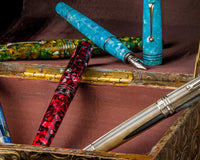Love words, agonize over sentences. And pay attention to the world.
⁓ Susan Sontag
The blank page patiently waits. It seems to say, “I am ready to accept your thoughts without fear or judgment. Be free.”

And so I begin, unleashing the heaviness of the day onto the pristine page. My emotions mark it — the movements of my hand echoing their intensity, the shading of the deposited ink reflecting my bodily expression. My handwriting is barely legible as what was knotted in my mind begins to unravel on paper. No matter. For as sentence after sentence fills the open space, calmness starts to settle in. I notice my breathing — it has become deeper, more regular. My heart beats slowly, steadily now.
One last punctuation mark and I am done. With a deep exhalation, I lay my pen down.
Our Quiet Companions
On May 18, we celebrate National Notebook Day. This is the time we recognize the significance of paper in all its bound forms. As part of the triumvirate essential to a fountain pen enthusiast’s toolkit, it truly deserves its own day of recognition. A notebook or journal is the blank canvas upon which we record our thoughts, emotions, creativity, inspirations, and parts of our lives. What would we do without it?

This celebration was born in 2016 through the efforts of the stationery company May Design. Since then, every third Thursday of May has been earmarked to commemorate the practice and benefits of keeping a handwritten account of our journey through life. This day also serves to remind us of the revitalizing connection between the human act of expressing ourselves through writing and the tools we create for this practice.
Historically, the first notebooks appeared in the 14th–15th century. They were lined by hand and were used primarily by schoolchildren. In 1888, Thomas William Holley established a small enterprise from his home — binding scrap paper from the paper mill he worked at and making inexpensive notebooks for sale. A judge requested several with the suggestion that they be stitched with a cardboard base for durability and ease of use. Thus, the legal pad was born. 1924 saw the launching of the spiral notebook, first used by inventor Edward Podosek.
Count The Ways
Ask anyone who uses fountain pens and inks and they will surely have something to say about their journals too. Aside from the tried-and-tested roles as planners, bullet journals, and school notes — here are some of my favorite and other, unorthodox ways of utilizing a bound collection of paper —
Creative space
Depending on the type of paper, you can use one for experimenting with different drawing styles or practicing calligraphy. This way, a journal can be a portable gallery of your artwork and a visual timeline of your process.
Personal expression
Time and again, studies have supported that keeping a journal for introspection encourages self-empowerment.
Self-care practice
Focusing on the mind-body connection, using a journal mindfully has been shown to benefit our overall well-being especially during those moments of solitude.
Commonplace book
Likewise known as commonplaces, this practice of keeping a compilation of useful information for rhetorical speaking has been traced to Aristotle, Cicero, and Quintilian. They became quite common during the Renaissance period and were used as repositories for aphorisms, poems, and proverbs — to name a few. In 1685, John Locke wrote a treatise in French detailing the method of creating a commonplace book. This personalized collection of ideas continues to inspire thinkers up to the present.
Time capsule
Like a nuanced memoir of sorts, a journal can be a private collection of letters to yourself or for others that you need not send.
Recreational documentation
Those of us who have discovered the highs and lows of D&D and other tabletop role-playing games are using journals as records of in-game events as well as in-character musings to add depth to the gameplay experience.
Esoteric exploration
In this age of open-mindedness and non-linear thinking, a journal can become a grimoire — a spellbook of techniques, processes, and learning as a companion on the path less-traveled. In addition to recognizing the various ways we can use a notebook or journal, another way of celebrating National Notebook Day is to craft one by hand. You can make it an activity for yourself or make it more enjoyable with friends and family (and snacks ;)).
Parting Words
One thing that ensures the continued existence of notebooks or journals in our lives is the experience we have as we use them. However we may do so, the common thread is woven from the feel of the paper, the movement of the nib on its surface, and the marks we create by hand. It is a sensorial understanding that keeps us in the moment, and heightens our awareness of it. It is still a far cry from the touch on the screen or the tap of the keyboard.

I write entirely to find out what I’m thinking, what I’m looking at, what I see, and what it means. What I want and what I fear.
⁓ Joan Didion
Use the code LEKZ10 to get a 10% discount!
* Not applicable for HopDrop, Clearance, On Sale items, and select brands.
Written by @lekzumali
Check out her musings on Instagram!








